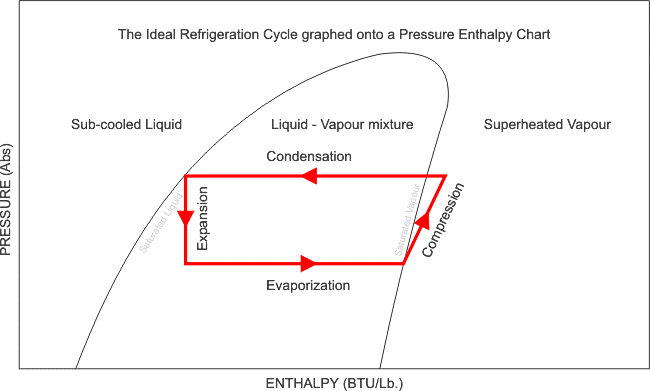
Refrigeration Primer
Refrigeration is based on the simple premise that liquids, including water, boil at different temperatures for a given pressure. Water on a stovetop boils at about 212 degrees at atmospheric pressure. Check your local conditions on your favorite weather app and you will see pressure measured around 30 inches of mercury, which translates to about 14.7 pounds per square inch.
If we were to take a tank, fill it half full of water, and suck all the air out, the pressure would drop and water would start to boil at lower and lower temperatures. Once all the air is removed, the remaining water will be about 32 degrees. That is refrigeration. The energy required to change the pressure is produced by a refrigeration compressor.
Most refrigeration cycles operate above atmospheric pressures, as refrigerants have different boiling points than water. Compressors take refrigerant from suction pressure (like the 32 degree tank of water) to high pressure, also known as head pressure in the industry.
Supermarket Refrigeration
Supermarkets use about three to four times more electrical energy than a typical office building, and their largest energy user is typically refrigeration.
For new supermarkets, codes for refrigeration may soon require: floating head pressure controls, mechanical sub-cooling, temperature termination defrost controls, electrically commutated motors, anti-sweat heater controls, and higher levels of insulation.
Anything that reduces the differential pressure from suction to head pressure, reduces the energy input for the refrigeration compressor. The image to the left is a typical pressure-enthalpy diagram of a refrigeration system. It’s similar to a ski hill. The ski lift acts as the compressor and is the most energy intensive part of the refrigeration system. So, anything that reduces the pressure difference will result in a shorter chair-lift ride.
Floating Suction
Refrigeration systems are typically controlled with a low and constant pressure/temperature set point. The colder set point ensures there is enough capacity all the time, particularly for a hot summer day. With no adjustments this “safety factor” is likely too conservative (meaning uses more energy than necessary), even for mid-summer, but more so, the rest of the year.
Suction pressure controls can adjust (or float) this temperature based on the load of the system. In the ski lift example, it would be as if you boarded the lift higher on the mountain instead of at the bottom. Some evaporator temperatures can be lifted as much as 2-10 degrees.
Floating Head
To save even more compressor energy, decrease the pressure exiting the compressor (let people off before the top of the mountain). Minimum head pressure is set by the need to push refrigerant through the system and to have control valves function properly. Head pressure must also be sufficient to condense refrigerant at a little above outdoor temperature, where heat is rejected from the system. Continuously adjusting this per outdoor conditions, saves energy virtually all year to a maximum savings any time it is below about 60 degrees outdoors.
Conclusion
If you want refrigeration savings this year, you’re likely to get pointed in the direction of one of these two control changes. Check your Utility’s energy efficiency program for potential assistance.




